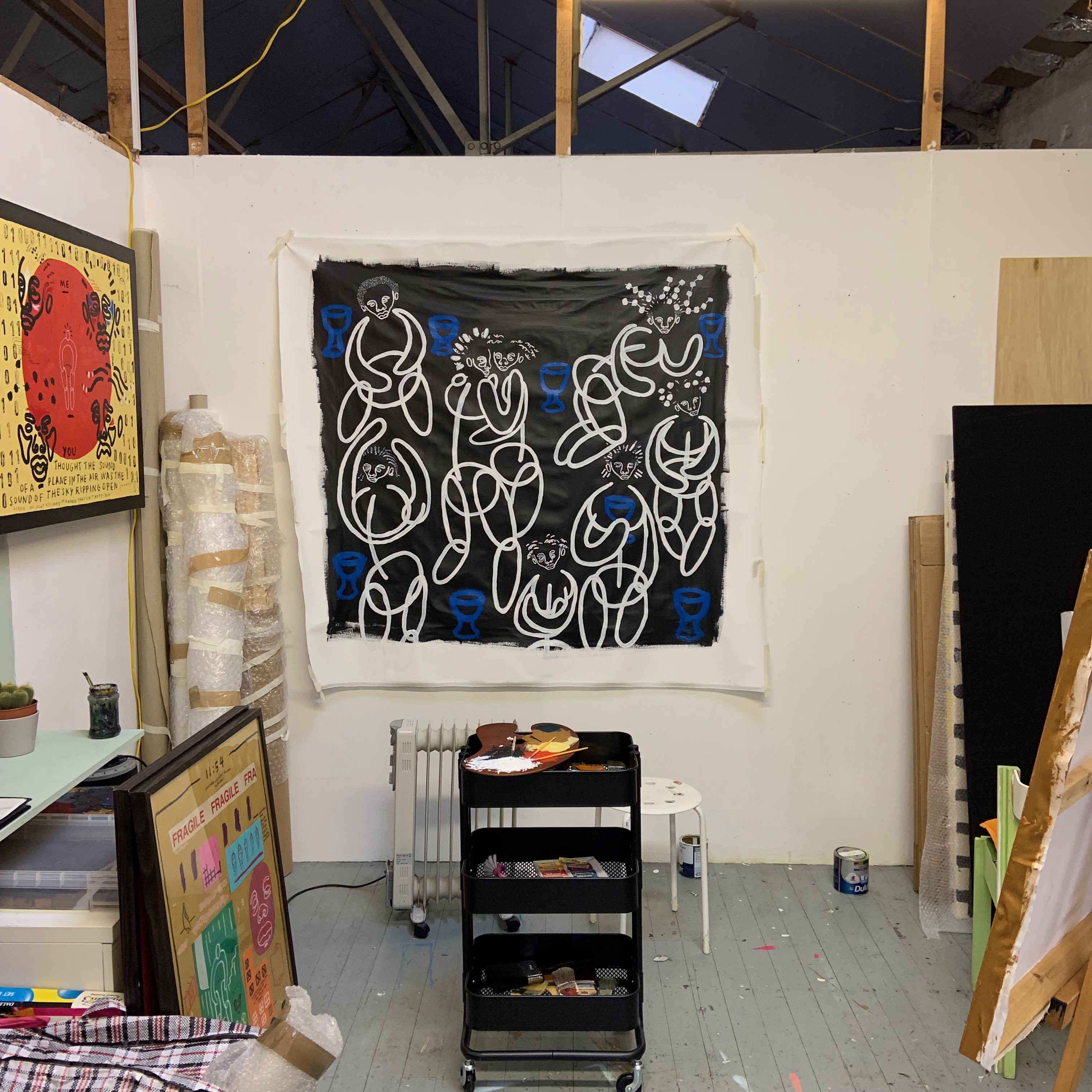Committing to a studio space can be a scary decision, particularly in cities where workshops and offices, not to mention housing, come at a premium. However, while working from home might save on your monthly outgoings, many designers and illustrators get to a point in their career where they find a desk at home is no longer cutting it.

MORE ROOM, FEWER CONSTRAINTS
For artist Joy Miessi, who has worked in a shared studio (that you can check out here) and recently moved into a co-operative space, their work needed more room in order to progress. “Working from my bedroom meant there was a limitation on some of the things I wanted to make or experiment with,” they told us. “Living in a flat with no lift meant my materials had to be lightweight, small and avoid sprays or fixatives in the process. I wanted to create more things than my space allowed me so I knew it was time when it was suggested to me. I started saving and then was able to get a small studio shared with two artists to start off.”
I wanted to create more things than my space allowed me
Miessi had reservations but says working away from home has helped them establish a regular routine, and given them the room to try different materials, as well as create bigger pieces and work on multiple projects at once. More than that, they say their flat has become a place to relax – unclouded by reminders of work.
A LINE BETWEEN LIFE AND WORK
For illustrator and designer Max Loeffler, renting a desk in a design and ad agency’s office has also been a creative catalyst. Despite describing himself as an introvert who enjoys working alone, after two years Loeffler was ready to have a dedicated space. “Sitting at home 8-9 hours a day, with no real need to get out of your joggers and no-one around except my dog (who is great company) and being all alone with my thoughts…. It was just enough at some point,” he explains. “I’m also the kind of person who benefits from really having to go to work, and not just walking into another room.”

Now, Loeffler works at his rented desk three or four days a week – which he describes as a “more energetic start to the working day”. Having a 20-minute drive to the office helps to separate work life and home life, the blurring of which is another common complaint among people who work from home regularly. “For me, working a few days from home and the bigger part away is the perfect mix, at the moment,” he says. “The dynamic working environment of a small design and ad agency helps me be more focused, as I’m not surrounded by all my stuff – which easily distracts me.”
There’s just another energy if you’re working among like-minded people
ABSORB CREATIVE ENERGY
Being in a dedicated studio space is also a chance to absorb creative energy, and both Miessi and Loeffler say being around others has been a huge motivator. Seeing the work of a former studio mate encouraged Miessi to learn how to weave, meaning they now incorporate more sewing into their pieces. “There’s just another energy if you’re working among like-minded people,” says Loeffler. “I feel more able to concentrate. Sometimes I’d love to share a studio with fellow illustrators and be able to chat about the stuff you only worry about when you’re a self-employed illustrator, but it’s refreshing and enriching to hear other views from people of other creative disciplines.”
BE PRAGMATIC
Obviously, there are downsides. Having a separate space is a significant financial commitment, which can be unrealistic for designers and artists still establishing themselves. For those worried they don’t have the means, Miessi suggests artists look at something like Bow Arts, which has a network of affordable spaces in London and the South East. (If you’re not based in London or the South East, it’s always worth researching for similar options in your own area too.) Miessi also recommends wariness. Costs can add up, particularly if bills aren’t included in the rent, and spaces can be far from ideal – think no heating, flooding, theft, and roof problems. “Artist insurance is an additional cost I didn’t foresee, but it should be considered if you choose to have a separate working space,” they add.
If all that sounds overwhelming, there are strategies for easing yourself into it. Caterina Bianchini, the founder of Caterina Bianchini Studio, describes her own experience of finding a studio space for her team as a gradual progression. She suggests people first try coworking as a way of gauging what they actually need from an office.

“That’s a really nice learning curve before you choose to set up your own,” she explains. “You think, ‘I want this big space with huge windows’, and then you get a bunch of computers and designers who can’t see their computers if blinds aren’t fitted. It’s all those tiny things. The first studio we went into didn’t have heating. I’d got so carried away because it was in a railway arch. And it was also super dark, so I had to fit lighting.”
THINK OF IT AS A PROGRESSION
For those dreading being stuck in yet another WeWork, Bianchini points out that there’s a lot of different options on offer, depending on what you want – whether that’s socialising and networking, or a place where you can come in and work quietly. “It feels like it’s a bit of a ladder,” she adds. “You start in these East London-y warehouse spaces, then you move up to something slightly better decorated and more grown up. Then you get a studio of your own.”
As well as deciding what space is right, it can be hard to know exactly when is the right time to make the transition. For Bianchini, similarly to Miessi and Loeffler, it was a natural progression. As she was collaborating with more freelancers – and working on more projects under NDA – she found she needed the extra space to discuss things out loud, and the freedom to flip through books and pin work on the walls.
For us it was important because then we could host clients in the studio
“The right time is when you’re able to sustain that rent, and when you feel like it might be an asset to the company,” she explains. “For us, it was important because then we could host clients in the studio, instead of meeting them in their workspace. We were working with bigger people, and it felt silly we couldn’t invite them to the studio for a meeting and to run through a deck.”

So for creatives currently wondering whether to move or not, it’s clear that having a studio can carry huge benefits. Still, though, it pays to be pragmatic in how you approach getting a space. Beware of workspaces that seem perfect but have underlying practical issues, and be ready to commit financially, not forgetting the hidden costs that crop up. For anyone not ready for a standalone studio, test the waters first with options such as co-working spaces and rented desks – which can be a good learning exercise for what you want, and don’t want, when you finally have your own space.
Catch the last article in our ‘How To’ series? If not, read it here: How To Manage Your Money.






